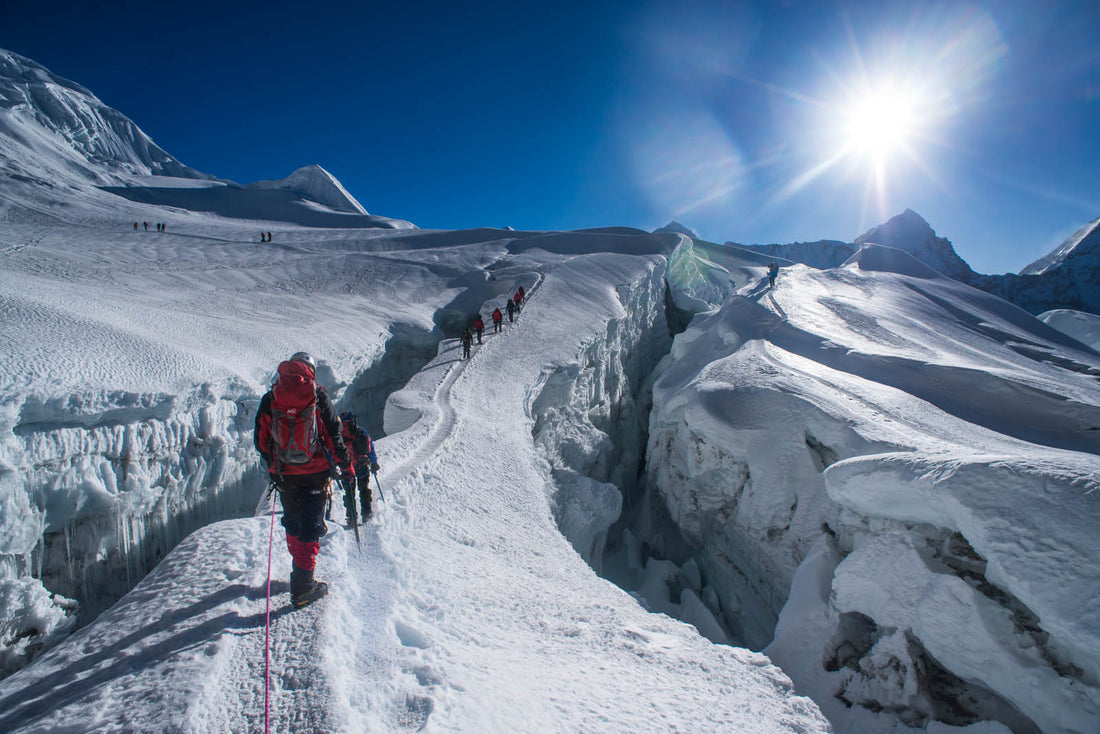
It's a dogs life proudly sponsors Himalayan expedition
Share
So just how and why would you climb a 20.305ft snow and ice covered peak in the Himalayas?
It was a typical wet and windy Lake District day, when I was sat in my office thinking about how I was going to try and educate people about Autism. Im lucky enough to be the father of two amazing daughters, the youngest of which has high functioning Autism.
For those of you that don't know Autism is a lifelong developmental disability that affects how a person communicates with, and relates to, other people. It also affects how they make sense of the world around them. People with the condition can also have difficulties with understanding speech and the rules of social interaction. They can also sometimes struggle to understand and deal with their own emotions.
The National Autistic Society help provide information, support and services for families affected by autism. They campaign tirelessly for a better world for autistic people.
As an Autism parent I'm often presented with a great deal of opportunities to be amazed and often humbled by my daughters determination and unique angle on life.
She faces a constant battle just to get through each day, every time she overcomes one of those challenges, it’s a time for me to be filled with admiration & joy.
It seemed to me that If she could face those daily challenges then I should face a challenge as well. I wanted to support the charity that was close to my heart and at the same time achieve something truly unique to help educate people about Autism.
I felt I needed to shout my message of Autism acceptance from the top of the world or at least as close to the top as I could get. It was then that I hit upon the idea. I would go to Nepal and climb in the Himalayas on behalf of my two daughters and The National Autistic Society.
I have always wanted to climb and now presented with this perfect opportunity, It seemed like as good a time as any to start.
The first thing I decided to do was make contact with my friend Shankar in Kathmandu, he runs his own trekking agency and I knew he would be more than up for an adventure.
I explained my idea and after much discussion it was he who suggested we climb Imja Tse.
Imja Tse is better known as Island Peak, it’s a 20,305ft snow covered mountain in Sagamatha National Park of the Himalayas in eastern Nepal. The peak was first named Island Peak in 1951 by Eric Shipton's party since it appears as a towering island in a sea of ice.
Imja Tse was first summited in 1953 as part of a training exercise by the 9th British Everest attempt, an expedition that would later go on to conquer Mount Everest.
That famous expedition included Charles Evans, Alf Gregory, Edmund Hillary, Charles Wylie and Tenzing Norgay, accompanied by seven Sherpas.
It was Tenzing Norgay and Edmund Hillary that would later go on that year to make the first successful summit attempt of Mount Everest. While Mount Everest is a mere six miles away to the north, our view from the summit would be blocked by the massive wall of Lhotse, ranked 4th highest in the world. Lhotse will tower an additional 2,300 m (7,500 ft) above our summit.
Shankar explained to me this wasn't for the faint hearted, it was going to be a technical climb and it was most likely going to hurt. Apart from scrambling I don't have much mountaineering experience.
I knew to achieve a successful summit this was going to be harder than anything else I had ever done before, but ultimately one of the greatest achievements of my life. We would after all, be following in the footsteps of legends.So after many emails and much deliberation It was finally agreed, we would climb Island Peak, the 1953 training peak for the first successful Mount Everest summit.
I started to research our summit route. Island Peak, is listed as an alpine pd+ grade climb.
We would need to climb in the alpine style, setting of from base or high camp with a backpack, summiting with a set of fixed ropes and back to camp all in one day.
I was beginning to have the realisation this is not an adventure you can do without the correct support. Shankar told me he had two friends who were also climbing island peak at the beginning of April and suggested we should join forces.
We needed to become a well prepared & organised team, at the bare minimum we needed one porter for every two climbers and one climbing sherpa to every two people climbing. Suddenly two had become eight and we had a mammoth task ahead of us.
I spent the next few weeks going over countless maps and youtube videos of the route and what obstacles lay in our path. It was going to take two weeks of trekking and acclimatisation just to get to the Imja glacier. We would need to pass Everest base camp and venture further into the east of the region.
Once we arrive at Island Peak, we have the option of starting the summit attempt from base camp at (16,690ft) and starting the climb between 2 and 3am. Our other option is to ascend to High Camp at around (18,400ft) to reduce the amount of effort and time needed for summit day.
However, adequate water supply and concerns about sleeping at a higher altitude may dictate starting from base camp. Base camp to high camp is basically a long hike but just above high camp their is some rocky steps which require moderate scrambling through a broad open gully.
At the top of the couloir we must traverse the stunning Imja glacier. There are a number of substantial crevasses along the glacier which will need to be crossed by fixed ladders.
These are a genuine cause for concern and have sometimes caused previous teams to turn back.
We must then proceed across the top of the glacier to the headwall, a 60 degree ice and snow covered slope. From here fixed ropes will be set for the strenuous ascent of 100 metres (330 ft) to the beginning of the summit ridge line.The climb from the ridge line to the summit is difficult due to the steep gradient and 250m traverse along a 1m wide ridge line to the summit peak which has a 6ft x 4ft summit area.
I was under no doubt to achieve the summit and raise awareness I was going to need help.
I needed corporate sponsorship for equipment and I needed some serious winter skills training in order to safely complete the challenge I had set myself.
I contacted many of the leading industry organisations asking for sponsorship support with this project, most didn't reply and those that did gave me a whole plethora of reasons why they didn't feel it was suitable for their business. After probably my 50th rejection email I decided to try a different approach.
I wrote a letter to the worlds greatest living explorer Sir Ranulph Fiennes and explained to him my expedition idea. I took a chance and asked him if he would be patron of my expedition and he graciously agreed. Re-energised by this amazing development I set about designing a new and detailed expedition proposal to send out to the equipment manufactures.
I decided I wanted this expedition to benefit the people of Nepal as well as support Autism awareness. From the research I had done on our route to Island peak, I knew we would be passing Pengbouche primary school which had been set up by Edmund Hillary during the 1953 Everest expedition. Shankar had told me that schools in the mountain areas desperately needed pencils. I knew we could help, so I approached Derwent a local lake district manufacturer with a separate proposal asking them to donate pencils to the expedition. I'm pleased to say they agreed to support the school and have kindly donated hundreds of high quality pencils.
I then approached a number of UK businesses asking if they could donate the much needed winter skills course. Most did not reply and some of those that did were a little unhelpful.
After a long search I came across the website of “Unexplored Scotland” I very much liked what I saw, so I sent in my proposal.
They immediately wrote back to me and said they would be delighted to help support such a worthy cause with a donation of winter skills training.
A few days later I received the fantastic news that Vango, Goal Zero, Its a Dogs Life and Lifesystems had also kindly offered their support to the expedition.
I had been humbled yet again, these business and kind individuals had just restored my faith in humanity, and I began thinking for the first time we just might be able to pull this off.
So now i train everyday, walking my dogs in the hills and taking photos along the way. All the time looking forward to my winter skills training in the Cairngorms and ultimately my big adventure in the Himalayas.
